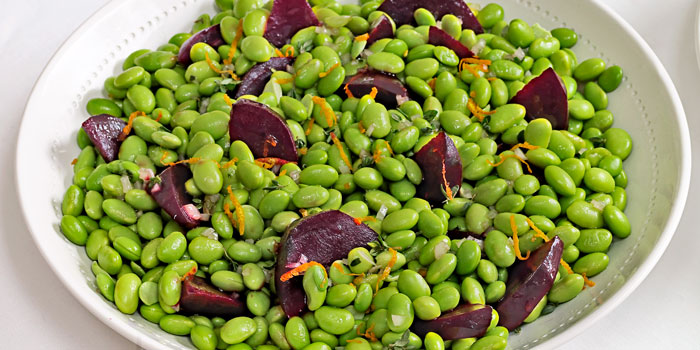
Pronounce it: soi-yah beenz
Soya beans and soy beans are exactly the same and the names are used interchangeably according to fashion, preference or habit. The many subsequent products, such as soya/soy sauce, are also exactly the same, whichever spelling is used.
Shoyu is the Japanese word for the same vegetable and its products – shoyu sauce is soya/ soy sauce.
The vital claim of the soya bean is that it is the only vegetable product that has all the protein content of meat, eggs or milk products and thus it’s essential to the diet of vegetarians and vegans. The beans themselves are bland and generally unappealing as they never quite develop the rich, meaty textures that other beans do with long cooking. Thus mature soya beans are used to make tofu, which is a soft or firm curd made from the milky liquid obtained by boiling and pressing soya beans and which retain the full protein content.
Young, green soya beans are much more appealing to eat and marketed widely as edamame.
Read our guide on the health benefits of soya.
Availability
Widely available dried.
Edamame are increasingly available fresh and frozen, and Asian food shops might sell them podded and frozen, which are much simpler to cook and use.
Choose the best
Check dried ones for broken pieces or any signs of infestation, indicating they are very old and tough.
Fresh, whole edamame should be a bright, appealing green with unwrinkled and unspotted skin. Frozen ones should not appear to have frost inside the pack as this indicates they have defrosted at some stage and might have deteriorated before being refrozen.
Store it
Dried soya beans should be stored somewhere cool and dark. An airtight container is recommended. Treat fresh or frozen edamame as you would any other green vegetable.
Cook it
Mature/dried soya beans are rarely used in cooking; they take many hours to cook and the hulls are indigestible to most people, causing digestive distress and pain if eaten in any quantity. They must be soaked overnight and then simmered until the insides are tender – the skins will rarely be so. Removing the hulls and then roasting the cooked beans will give a very nutritious snack that might be flavoured with all manner of spices, soy sauce, tomato purée etc. but the long, laborious processes involved might be thought an unproductive use of time.
Edamame in the pods are boiled, steamed or microwaved; usually served and eaten as a snack, they’re offered in small quantities and the young beans popped from the pods in the mouth. Most people find eating the pods themselves rather unpleasant.
The small green podded beans make an unusual vegetable and are a good way to add full protein to a meal for those who are not fond of tofu or other soya bean products. They make a very good Oriental alternative to green peas in rice salads, hot or cold pilaffs, noodle or pasta dishes.
Be the first to comment on "Soya beans"